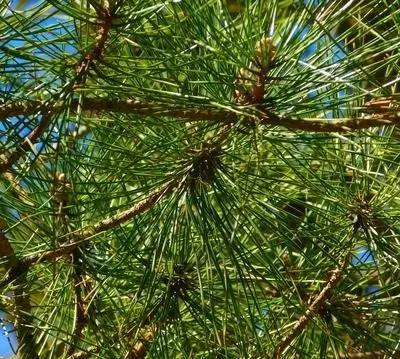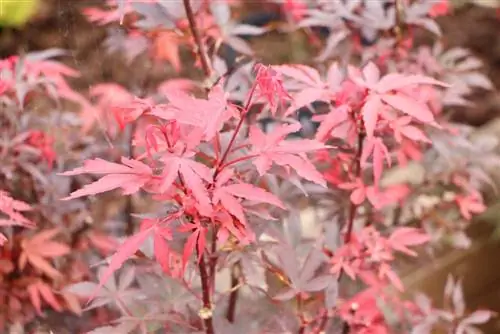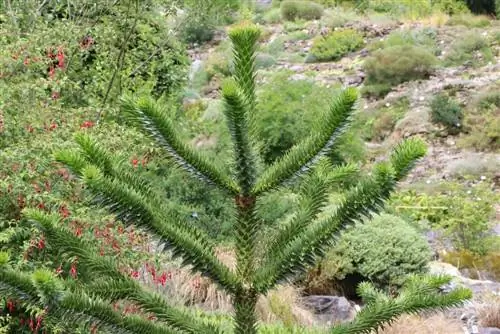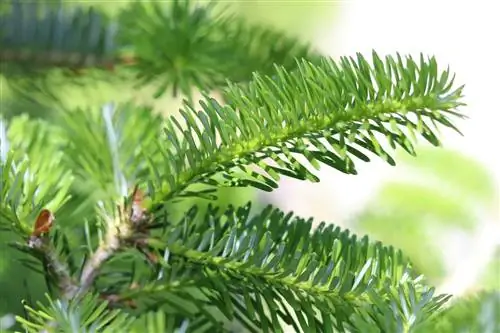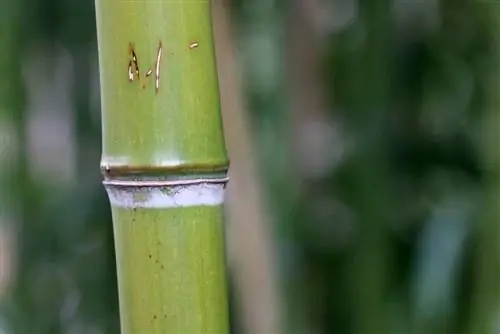- Author admin [email protected].
- Public 2023-12-17 03:39.
- Last modified 2025-01-24 12:45.
The needles of the Japanese umbrella fir look like the umbrellas on a cocktail glass. As a solitary plant in the garden or cultivated in a pot, the decorative conifer can really develop. In the first few years of life, the plant develops more like a bush. Only after about 10 to 15 years does it become a columnar tree. But Sciadopitys verticillata places some demands on the hobby gardener and is sometimes not that easy to care for.
Location
Finding the ideal location for the Japanese umbrella fir is a bit difficult. Because here she is very demanding. It likes it sunny to partially shaded, but in winter you should avoid direct sunlight. The fir should also be cultivated in a location protected from the wind. However, this can be a bit difficult because the fir doesn't like taller plants that surround it. Therefore, the ideal location should be chosen as follows:
- bright and sunny
- but avoid direct winter sunlight
- in front of a wall or in a corner
- still far enough away
- if the corner is narrow, then the umbrella fir doesn't like it
- next to a taller tree
- There should be enough space in between
Tip:
If you cannot provide the ideal location in the garden for all the desired conditions, you can also cultivate the umbrella fir in a bucket that is placed on a mobile base. This means that the plant can be easily relocated again and again depending on the conditions at the respective location.
Substrate & Soil
The maintenance-intensive umbrella fir also has a lot of demands on the substrate. Since it should have the following characteristics in particular, rhododendron soil, bog soil or peat soil are well suited:
- nutrient-rich
- moist but permeable
- calcareous
- sandy
- The existing garden soil is mixed accordingly
- You can also fill rhododendron soil directly into the planting hole or bucket
Watering & Fertilizing
The Japanese umbrella fir does not necessarily need to be fertilized. However, if there is a nutrient deficiency, which can be easily identified by yellow or brown needles, action should be taken. However, the umbrella fir cannot tolerate a longer dry period and must therefore be watered regularly, especially if it does not rain for a long time. This is also the case in winter; if there is a long period of dry cold, watering must also be done on frost-free days. Brown needles also appear on an umbrella fir tree that suffers from drought. The decorative plant also likes to have a shower from above during long periods of drought. However, only do this in the evening hours to avoid burns when exposed to sunlight. However, only low-lime water should be used for irrigation water, so ideally use collected rainwater. When fertilizing due to a nutrient deficiency, you should proceed as follows:
- April is optimal for adding fertilizer
- Fix compost
- Use fir fertilizer or long-term fertilizer for fir trees
- Pour manure over the ground
- these fertilizers are ideal
- they contain nitrogen, phosphorus but also zinc and iron
Tip:
Yellow needles on the Japanese umbrella fir can have many causes. The hobby gardener usually knows best why his own fir tree gets yellow needles. In addition to the lack of nutrients, it can also be due to over-fertilization, prolonged dryness of the soil or too much moisture.
Plants
Once the right location has been chosen for the Japanese umbrella fir, it can be planted. Like many other trees, firs are sold commercially as potted plants or bales. Sciadopitys verticillata can be planted all year round, just not on frosty days. If the baled goods were chosen, the time over the winter, from October to April, should be chosen as the planting time. Then proceed as follows:
- Dig up and prepare soil
- Dig the planting hole twice as large as the root ball
- Put the fir tree in a pot of water
- Put drainage on the bottom of the planting hole to prevent waterlogging
- Spread stones or shards of pottery on the ground
- Put on the umbrella fir tree
- Fill soil all around
- make sure that the trunk is vertically straight
- Press the soil lightly and water well
- water well for the first few days
Tip:
If bale goods were purchased, there is a cloth or net around the root ball. This should be cut open when inserting. However, it can remain in the soil altogether as it dissolves on its own as it is made of natural materials that decompose after some time.
Transplanting
The umbrella fir is one of the few trees that doesn't mind being transplanted. If the old location is no longer optimal for the coniferous tree, a new one can be found. The best times for transplanting are autumn and winter. However, a frost-free period must be chosen here. The roots of the umbrella fir should be given more space in the new planting hole. Otherwise, the procedure is exactly the same as for planting. However, if the fir tree is dug up at its old location, great care must be taken so that the sharp spade does not injure the roots. Therefore, stake out and dig out the earth far enough around the trunk.
Cultivation in a bucket
If you don't have enough space for the sprawling umbrella fir in the garden, you can also cultivate it in a bucket, because the graceful fir trees are even planted and valued as bonsai. This means it can adapt to its environment, and therefore also to a pot, and grows slower if it cannot expand with its roots. The ideal location is particularly important when keeping containers. Under no circumstances should it be in full sun; it is better if the pot is in the shade, the fir tree itself can tolerate sun. But the soil in the pot with direct sunlight dries out much faster, which the Japanese umbrella fir cannot tolerate at all. When planting in containers, you should also pay attention to the following:
- create a drainage over the drain hole
- How to avoid dangerous waterlogging
- to do this, place potsherds or stones over the hole
- place plant fleece over this so that no soil clogs the drainage
- fill in a portion of prepared soil
- Insert umbrella fir, fill in remaining soil
- pour well
- half an hour later, drain excess water from the plate
Repotting
It must be repotted at the latest when the roots of the plant start to look upwards. Then the bucket became too small. Since it is a shallow-rooted plant, the roots only grow in width and, if there is a lack of space, upwards. But ideally the Japanese umbrella fir should be given a new, slightly larger pot every two years at the latest. When repotting, the procedure is the same as when planting in a bucket.
Cutting
Sciadopitys verticillata generally does not require cutting. Because it has a very slow growth and, above all, grows very regularly and densely. This beautiful growth habit given by nature should under no circumstances be destroyed by cutting. Only if the conifer takes up too much space can it be shortened on the sides. However, care must always be taken to ensure that no holes are cut into the dense growth. These may no longer grow. The leading shoot should also never be cut.
Sowing
Hobby gardeners who already own an older umbrella fir have the opportunity to harvest the pine cones here. However, these only form in later years; young fir trees do not yet produce fruit. To obtain the seeds, the cones are removed from the tree and placed in a warm, dry place to dry out. When the cones open, the seeds fall out on their own. Germination is a lengthy process, so a lot of patience is required. When sowing, proceed as follows:
- Fill pots or bowls with potting soil
- insert the seeds and water them lightly
- cover with a transparent film during the germination period
- ventilate every now and then
- Keep soil moist
- place in a warm, bright place
- only after 100 days or later do the first seedlings appear
- even after that, growth is very slow
- only plant out when the fir trees have reached a size of 5 to 10 cm
Tip:
If you don't have the opportunity to harvest the umbrella fir seeds yourself, you can also ask at well-stocked specialist retailers. The seeds are often offered for sale here.
Propagate
The decorative coniferous tree can also be propagated by cuttings. But this method is often not so successful. However, if you have a little patience, you can still use shoots from your Japanese umbrella fir to attempt propagation. You should proceed as follows:
- select half-ripe shoots in summer
- cut these and put them in potting soil
- Keep soil moist
- Put a transparent film over the cuttings
- keep it bright and warm
- if roots have formed, move to a larger container
- put outside in summer
- If the tree is big and strong enough, it can be planted out
Wintering
The umbrella fir is generally well tolerated by frost. Nevertheless, their roots should be protected from frost in the ground. Mulch and leaves from other trees and bushes that have fallen in autumn are suitable for this. These are not picked up and disposed of, but distributed directly on the ground around the fir tree. This protects the earth from drying out in winter and from frost. If Sciadopitys verticillata was cultivated in a pot, it should be moved to a protected place in winter. The bucket is also wrapped with brushwood mats or plant fleece, and some mulch is also added to the soil. What is particularly important is that the umbrella fir is protected from the winter sun, which it cannot tolerate. So it can be placed in a bucket in a shady place. If the tree is in the garden bed, it must be provided with sun protection if this is not provided naturally, for example in the shade of a house. You can proceed as follows:
- If the tree is still small, a parasol is enough
- even the big fir tree can hardly tolerate winter sun
- plant a tree nearby at the same time as the umbrella fir
- However, there must be enough space between the tree and the umbrella fir
Tip:
A faster-growing tree can also be planted near the umbrella fir in the direction of the sun, which can then provide the fir with enough shade in winter. If the sun is higher in the sky in the summer months, it can still reach the umbrella fir.
Care errors, diseases or pests
Yellow needles can appear due to errors in care, for example dryness, too much moisture or a lack of nutrients. Then the hobby gardener has to find the cause in order to counteract it. If the soil is too wet, a fungal disease can develop that could be dangerous to the fir tree. Root rot can also occur, and even then the umbrella fir can often no longer be saved. If there is a nutrient deficiency, chlorosis can occur. But here too you can counteract this with the right fertilizer. Unfortunately, pests are also known:
- spider mites appear on the fir tree at a young age
- these can be controlled with special commercial insecticides
Conclusion
If you want to cultivate the decorative Japanese umbrella fir in your garden, you will need a little time to care for it. The location is particularly important in order to provide the tree with the best environment. It places many different demands on this, which perhaps cannot all be met together. If you still don't want to do without this piece of jewelry, you can also cultivate the fir tree in a bucket that is placed on a mobile base. This means that the plant can always be assured of the ideal location, depending on the circumstances. However, once you have decided on this decorative coniferous tree, with good care you can enjoy a beautiful, graceful, evergreen and decorative tree for many years.

